

The Function of the Scrum and Sprint within an Agile Project. 1 of 5.

A practical lean startup guide. The science of turning an idea into a business We published a book!
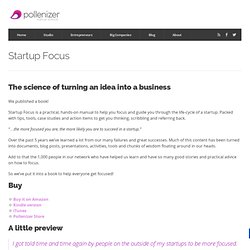
Startup Focus is a practical, hands-on manual to help you focus and guide you through the life-cycle of a startup. Packed with tips, tools, case studies and action items to get you thinking, scribbling and referring back. “…the more focused you are, the more likely you are to succeed in a startup.” Over the past 5 years we’ve learned a lot from our many failures and great successes. Add to that the 1,000 people in our network who have helped us learn and have so many good stories and practical advice on how to focus. So we’ve put it into a book to help everyone get focused! Buy. Feature-driven development. History[edit] FDD was initially devised by Jeff De Luca to meet the specific needs of a 15-month, 50-person software development project at a large Singapore bank in 1997.

Jeff De Luca delivered a set of five processes that covered the development of an overall model and the listing, planning, design and building of features. The first process is heavily influenced by Peter Coad's approach to object modeling. The second process incorporates Peter Coad's ideas of using a feature list to manage functional requirements and development tasks. Agile Joomla Web Design: The Planning Phase. The most important part of the website design process happens way before one line of code is written or one graphic created. The new design methodologies. Agile Web Development That Works. Agile web development is not a specific process, action, or a daylong exercise.
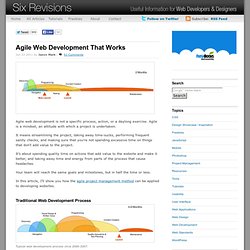
Agile is a mindset, an attitude with which a project is undertaken. It means streamlining the project, taking away time-sucks, performing frequent sanity checks, and making sure that you’re not spending excessive time on things that don’t add value to the project. It’s about spending quality time on actions that add value to the website and make it better, and taking away time and energy from parts of the process that cause headaches. Your team will reach the same goals and milestones, but in half the time or less. In this article, I’ll show you how the agile project management method can be applied to developing websites. The Lean Startup Circle Wiki / Case Studies.
Eric Ries Remarks I've been really inspired by this case study and the resulting discussion.
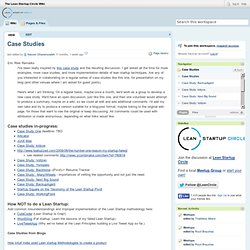
I get asked all the time for more examples, more case studies, and more implementation details of lean startup techniques. Are any of you interested in collaborating on a regular series of case studies like this one, for presentation on my blog (and other venues where I am asked for guest posts). Here's what I am thinking. How To Build A Startup: The Lean Launchpad. Business Model Canvas vs Lean Canvas vs One-Page Lean Startup. How To Build a Web Startup – Lean LaunchPad Edition. If you’re an experienced coder and user interface designer you think nothing is easier than diving into Ruby on Rails, Node.js and Balsamiq and throwing together a web site.

(Heck, in Silicon Valley even the waiters can do it.) But for the rest of us mortals whose eyes glaze over at the buzzwords, the questions are, “How do I get my great idea on the web? What are the steps in building a web site?” And the most important question is, “How do I use the business model canvas and Customer Development to test whether this is a real business?” My first attempt at helping students answer these questions was by putting together the Startup Tools Page - a compilation of available web development tools. So today, I offer my next attempt.
Agile developmentx. Agile software development. Agile software development is a set of principles for software development in which requirements and solutions evolve through collaboration between self-organizing,[1] cross-functional teams.
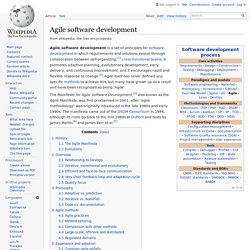
It promotes adaptive planning, evolutionary development, early delivery, and continuous improvement, and it encourages rapid and flexible response to change.[2] Agile itself has never defined any specific methods to achieve this, but many have grown up as a result and have been recognized as being 'Agile'. The Manifesto for Agile Software Development,[3] also known as the Agile Manifesto, was first proclaimed in 2001, after "agile methodology" was originally introduced in the late 1980s and early 1990s.
The manifesto came out of the DSDM Consortium in 1994, although its roots go back to the mid 1980s at DuPont and texts by James Martin[4] and James Kerr et al.[5] History[edit] Incremental software development methods trace back to 1957.[6] In 1974, E. Manifesto for Agile Software Development. User story. History[edit] User stories originated with Extreme Programming (XP), whose first written description in 1998 only claimed that customers defined project scope "with user stories, which are like use cases".
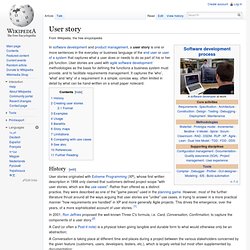
Rather than offered as a distinct practice, they were described as one of the "game pieces" used in the planning game. The Kaizen Project. How to Get Startup Ideas. November 2012 The way to get startup ideas is not to try to think of startup ideas.

It's to look for problems, preferably problems you have yourself. The very best startup ideas tend to have three things in common: they're something the founders themselves want, that they themselves can build, and that few others realize are worth doing. Viral marketing is not a marketing strategy. Many times, viral marketing is seen as a “marketing strategy” that is interchangeable with other methods of acquiring users.
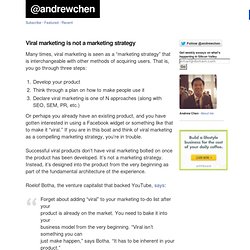
That is, you go through three steps: Develop your productThink through a plan on how to make people use itDeclare viral marketing is one of N approaches (along with SEO, SEM, PR, etc.) Or perhaps you already have an existing product, and you have gotten interested in using a Facebook widget or something like that to make it “viral.” If you are in this boat and think of viral marketing as a compelling marketing strategy, you’re in trouble. Successful viral products don’t have viral marketing bolted on once the product has been developed. Lean Startup. Lean startup is a methodology for developing businesses and products.
The methodology aims to shorten product development cycles by adopting a combination of business-hypothesis-driven experimentation, iterative product releases, and validated learning. The central hypothesis of the lean startup methodology is that if startup companies invest their time into iteratively building products or services to meet the needs of early customers, they can reduce the market risks and sidestep the need for large amounts of initial project funding and expensive product launches and failures.[1][2] History[edit] Although the lost money differed by orders of magnitude, Ries concluded that the failures of There, Inc. and Catalyst Recruiting shared similar origins: "it was working forward from the technology instead of working backward from the business results you're trying to achieve.
Precursors[edit] Overview[edit] Definitions[edit] Here's What The Average Tech Startup Looks Like. Between reading GeekWire every day, watching the Tech Stars Seattle Demo Day pitches, seeing the latest infographic from Gist, talking to Angels and VCs, and discussions with fellow venture backed entrepeneurs, I have lately been wondering what the “average” tech startup looks like today. It is a lot smaller than I had thought. To help answer this question, I turned to the detailed information published on the Tech Stars web site. This is a treasure trove of statistics, listing 104 graduate startups, from the initial 2007 class in Boulder to the Spring 2011 classes in Boulder, Boston, and New York (including 2010 Seattle, but not the Fall 2011 Seattle graduates).
Unfortunately, YCombinator and 500 Startups do not post equivalent data on their 350+ similar graduates, but 104 is quite a good sample size. First to note, is that although Tech Stars is five years old, 84 of the 104 companies listed are less than three years old. Who knew? Links included above: